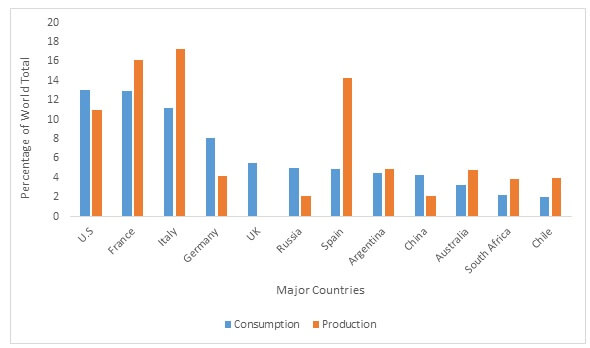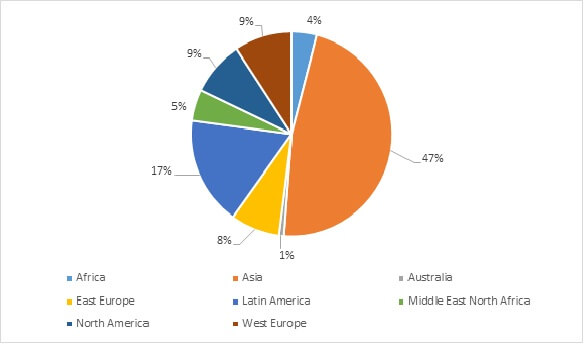The recent decade has witnessed an increase in the global production and consumption of a wide variety of beverages. Consumption of beverages in different regions of the world is linked to various factors, such as standard of living, demand and supply of different types of beverages in the particular region, recent trends and other market dynamics, in the market.
Recent trends in the global beverage market, such as new flavors, functional beverages trend, innovative product types and religious preferences are influencing consumer buying behavior.
Among different types of beverages, quality is of utmost importance when it comes to a few alcoholic beverages such as wine and beer and nonalcoholic beverages such as juice or carbonated drinks.
Beverage clarifiers and stabilizers are inevitable in the process of beverage production, such as fruit juice, wine, beer and other alcoholic and non-alcoholic beverages. A beverage clarifier and stabilizer not only improves the visual appeal of the drink but also enhances its taste.
Beverage clarifiers and stabilizers are emerging as the most required prerequisites in the beverage manufacturing process. Beverage clarifier and stabilizer agents are required to meet a wide variety of needs from the food and beverage industry.
Beverage clarifiers and stabilizers are used to provide cold stabilization of beer, they are also used for microbial stabilization of alcoholic beverages, such as wine, and for getting rid of unwanted particles in fruit juices that affect the overall taste and quality of the beverage.
They also help beverage manufacturers get rid of contamination. A beverage clarifier and stabilizer is one of the most important prerequisites in the production of a few alcoholic beverages.
For instance, in the wine making process, clarification is one of the most primary steps followed to remove yeast and other impurities to improve the quality of the wine and make it a fine wine product.
The above diagrammatic representation shows major countries and their production and consumption share in the world total for fine wine.
Italy, France and Spain hold a major share in the production of fine wine, which makes use of beverage clarifier and stabilizer agents for the fining of wine, hence the European region dominates the fine wine market.

Other regions are expected to witness an increase in the production of fine wine in the coming few years and hence, there is an expected increase in the demand for the beverage clarifier and stabilizer agents.
Some of the key players operating in the global beverage clarifier and stabilizer market are Ashland, 3M, Tolsa Group, Eaton, BASF SE, DSM Chemicals, Dow Chemical Company, Akzonobel Chemicals, Scott Laboratories, AGROVIN, KOMPASS TERNATIONAL, SA W. R. Grace & Co. and others.
Launching new product variants, acquiring the smaller players in the market, generating awareness about the benefits of clarifying and stabilizing beverages through various promotional activities and programs are some of the key drivers expected to support the market growth in the near future.

The beverage clarifier and stabilizer market is expected to show exponential growth in North America and Europe in the next few year as the average consumption of non-alcoholic beverages has been on the rise around the globe. There is a lot of scope for the growth of the beverage clarifier and stabilizer market in Asia Pacific and the rest of the world.
Catering to the growing demand for products containing several benefits is one of the key supply-side drivers supporting the beverage clarifier and stabilizer market growth.
The right kind of filtration and clarification technology, undisturbed supply of clarification and stabilization agents and proper management skills in the beverage clarifier and stabilizer market around different regions in the world may provide opportunities for investment in the beverage clarifier and stabilizer market.
We will follow a modelling-based approach and triangulation methodology to estimate data covered in this report. A detailed market understanding and assessment of the applications, types, forms and end uses of the product segments covered in the study is followed by carrying out a demand-side approach to estimate the sales of target product segments, which is then cross-referenced with a supply-side assessment of value generated over a pre-defined period.
The statistics and data are collected at a regional level, consolidated and synthesized at a global level to estimate the overall market sizes.
Some of the key data points covered in our report include:
The research report presents a comprehensive assessment of the market and contains thoughtful insights, facts, historical data, and statistically supported and industry-validated market data.
It also contains projections using a suitable set of assumptions and methodologies. The research report provides analysis and information according to market segments such as geographies, application, and industry.
The report is a compilation of first-hand information, qualitative and quantitative assessment by industry analysts, inputs from industry experts and industry participants across the value chain.
The report provides in-depth analysis of parent market trends, macro-economic indicators and governing factors along with market attractiveness as per segments. The report also maps the qualitative impact of various market factors on market segments and geographies.
On the basis of the beverage clarifier and stabilizer agent, the global beverage clarifier and stabilizer market can be segmented as:
On the basis of the beverage clarifier and stabilizer type, the global beverage clarifier and stabilizer market can be segmented as:
On the basis of the beverage type, the global beverage clarifier and stabilizer market can be segmented as:
On the basis of the region, the global beverage clarifier and stabilizer market can be segmented as:






Full Research Suite comprises of:
Market outlook & trends analysis
Interviews & case studies
Strategic recommendations
Vendor profiles & capabilities analysis
5-year forecasts
8 regions and 60+ country-level data splits
Market segment data splits
12 months of continuous data updates
DELIVERED AS:
PDF EXCEL ONLINE
Beverage Packaging Market Size and Share Forecast Outlook 2025 to 2035
Beverage Carrier Market Size and Share Forecast Outlook 2025 to 2035
Beverage Cartoners Market Size and Share Forecast Outlook 2025 to 2035
Beverage Filter Paper Market Size and Share Forecast Outlook 2025 to 2035
Beverage Ingredients Market Analysis - Size and Share Forecast Outlook 2025 to 2035
Beverage Packaging Equipment Market Size and Share Forecast Outlook 2025 to 2035
Beverage Clouding Agent Market Size and Share Forecast Outlook 2025 to 2035
Beverage Packaging Machine Market Size and Share Forecast Outlook 2025 to 2035
Beverage Premix Market Size and Share Forecast Outlook 2025 to 2035
Beverage Acidulants Market Size and Share Forecast Outlook 2025 to 2035
Beverage Refrigeration Market Size and Share Forecast Outlook 2025 to 2035
Beverage Tester Market Size and Share Forecast Outlook 2025 to 2035
Beverage Dispenser Market Size and Share Forecast Outlook 2025 to 2035
Beverage Container Market Size and Share Forecast Outlook 2025 to 2035
Beverage Can Ends Market Size and Share Forecast Outlook 2025 to 2035
Beverage Cups Market Size and Share Forecast Outlook 2025 to 2035
Beverage Can Seamers Market Size and Share Forecast Outlook 2025 to 2035
Beverage Aluminum Cans Market Size and Share Forecast Outlook 2025 to 2035
Beverage Emulsion Market Analysis - Size, Share, and Forecast Outlook 2025 to 2035
Beverage Crate Market Analysis – Size, Share, & Forecast Outlook 2025 to 2035

Thank you!
You will receive an email from our Business Development Manager. Please be sure to check your SPAM/JUNK folder too.
Chat With
MaRIA